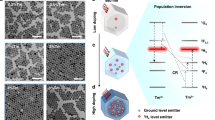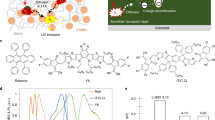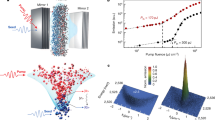Abstract
There is currently renewed interest in the development of lasers using solid-state organic and polymeric materials as the gain media. These materials have a number of properties that make them good candidates for such applications — for example, emission bands that are displaced (via a Stokes shift) from absorption bands, and the ease with which the emitting species can be embedded in a suitable host material1,2,3,4,5. But despite these advantages, the threshold power densities required for light amplification that have been reported so far have been high6,7,8. Here we describe an approach, based on energy transfer between molecular species, that can lower the threshold for stimulated emission and laser action while improving markedly the waveguiding properties of the active material. In our materials, an initial molecular excited state is generated in the host compound by absorption of light; this state is then resonantly and non-radiatively transferred down in energy (through one or more steps) between suitably matched dye molecules dispersed in the host, so ensuring that the absorption losses at the final emission wavelengths are very small. Such composite gain media provide provide broad tunability of the emission wavelength, and also decouple the optical emission properties from the transport properties, so providing greater flexibility for the design of future electrically driven device structures.
This is a preview of subscription content, access via your institution
Access options
Subscribe to this journal
Receive 51 print issues and online access
$199.00 per year
only $3.90 per issue
Buy this article
- Purchase on Springer Link
- Instant access to full article PDF
Prices may be subject to local taxes which are calculated during checkout




Similar content being viewed by others
References
Schafer, F. P. in Topics in Applied Physics: Dye Lasers 3rd edn (ed. Schafer, F. P.) Ch. 1 (Springer, Berlin, (1990)).
Weber, H. P. & Ulrich, R. Athin film ring laser. Appl. Phys. Lett. 19, 38–40 (1971).
Kogelnik, H. & Shank, C. V. Stimulated emission in a periodic structure. Appl. Phys. Lett. 18, 152–154 (1971).
Kaminov, I. P., Weber, H. P. & Chandross, E. A. Poly(methyl methacrylate) dye laser with internal diffraction grating. Appl. Phys. Lett. 18, 497–499 (1971).
Gonokami, M. et al. Polymer microdisc and microring lasers. Opt. Lett. 20, 2093–2095 (1995).
Tessler, N., Denton, G. J. & Friend, R. H. Lasing from conjugated polymer microcavities. Nature 382, 695–697 (1996).
Hide, F. et al. Semiconducting polymers: a new class of solid state laser materials. Science 273, 1833–1836 (1996).
Frolov, S. V. et al. Cooperative emission in π-conjugated polymer thin films. Phys. Rev. Lett. 78, 729–736 (1997).
Förster, T. Transfer mechanisms of electronic excitation. Disc. Faraday Soc. 27, 7–17 (1959).
Van Der Meer, B. W., Coker, G. & Chen, S. Y. in Resonance Energy Transfer Ch. 2 (VCH, New York, (1994)).
Acknowledgements
We thank A. Timko and O. Nalamasu for the gratings, and E. A. Chandross and H.E.Katz for comments.
Author information
Authors and Affiliations
Corresponding author
Rights and permissions
About this article
Cite this article
Berggren, M., Dodabalapur, A., Slusher, R. et al. Light amplification in organic thin films using cascade energy transfer. Nature 389, 466–469 (1997). https://doi.org/10.1038/38979
Received:
Accepted:
Issue Date:
DOI: https://doi.org/10.1038/38979
This article is cited by
-
Transporting and concentrating vibrational energy to promote isomerization
Nature (2021)
-
Full-color laser displays based on organic printed microlaser arrays
Nature Communications (2019)
-
Amplified Spontaneous Emission in Paper
Scientific Reports (2019)
-
Detailed Balance Limit of Efficiency of Broadband-Pumped Lasers
Scientific Reports (2017)
-
Perovskite energy funnels for efficient light-emitting diodes
Nature Nanotechnology (2016)
Comments
By submitting a comment you agree to abide by our Terms and Community Guidelines. If you find something abusive or that does not comply with our terms or guidelines please flag it as inappropriate.



